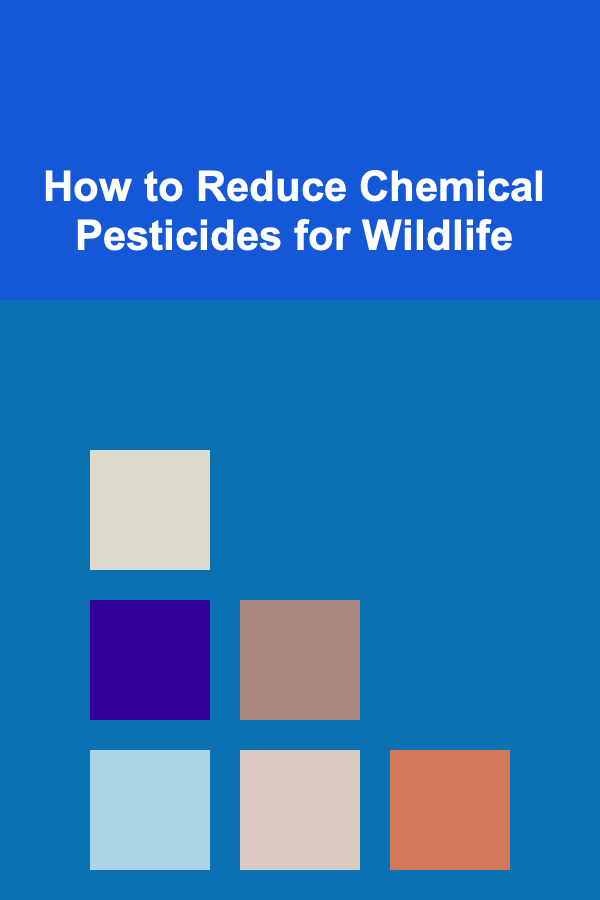
How to Reduce Chemical Pesticides for Wildlife
ebook include PDF & Audio bundle (Micro Guide)
$12.99$5.99
Limited Time Offer! Order within the next:

Chemical pesticides have long been used to protect crops from pests and diseases. While effective, their widespread use has raised serious concerns about environmental and ecological impacts. One of the most alarming consequences is their adverse effect on wildlife. In this article, we will explore how chemical pesticides harm wildlife, the need for reduction, and various strategies and alternatives to reduce pesticide use to safeguard biodiversity and ensure a sustainable ecosystem.
The Dangers of Chemical Pesticides on Wildlife
Chemical pesticides are designed to target specific pests, but their impact extends far beyond the intended targets. Pesticides are often toxic to a wide range of species, including non-target insects, mammals, birds, and aquatic life. Here are several ways in which chemical pesticides negatively affect wildlife:
1. Toxicity to Beneficial Insects
Many chemical pesticides, such as neonicotinoids and organophosphates, are highly toxic to beneficial insects like bees, butterflies, and other pollinators. These insects play a crucial role in pollination, a process essential for plant reproduction and food production. The loss of pollinators due to pesticide exposure has been linked to the decline of biodiversity and the disruption of ecosystems. The famous case of Colony Collapse Disorder (CCD) in honeybees has raised awareness about how pesticides harm insect populations.
2. Aquatic Contamination
When pesticides are sprayed on crops, they often run off into nearby water sources during rain or irrigation. This runoff leads to the contamination of rivers, lakes, and oceans, endangering aquatic life. Fish, amphibians, and invertebrates are particularly vulnerable to pesticide exposure. For instance, pesticides can disrupt the reproductive systems of aquatic organisms, leading to population declines. The pesticide DDT, which was banned in many countries due to its harmful effects, still has lingering consequences on aquatic ecosystems.
3. Bioaccumulation and Biomagnification
Pesticides can enter the food chain through bioaccumulation and biomagnification. Bioaccumulation occurs when an individual organism accumulates toxic substances faster than it can eliminate them. Biomagnification refers to the increasing concentration of toxins as they move up the food chain. For example, a bird of prey that feeds on contaminated rodents will accumulate higher levels of pesticides than the rodents themselves. This accumulation can cause reproductive failures, weakened immune systems, and even death.
4. Soil Health and Terrestrial Wildlife
Chemical pesticides also degrade soil health. Healthy soils are home to a wide variety of organisms, including earthworms, microbes, and fungi, which contribute to soil fertility and ecosystem health. Pesticides can kill or harm these beneficial organisms, leading to poorer soil structure and reduced nutrient availability for plants. This degradation of soil health can negatively impact plant life, which, in turn, affects herbivores and the larger food chain.
5. Hormonal Disruption in Wildlife
Many pesticides, particularly those containing endocrine-disrupting chemicals (EDCs), can interfere with the hormonal systems of wildlife. EDCs mimic or block hormones in animals, leading to altered development, behavior, and reproductive functions. In amphibians, exposure to pesticides has been linked to deformities and population declines. In some cases, EDCs may cause gender imbalances, further threatening the survival of species.
Why Reducing Chemical Pesticides Is Essential for Wildlife
The evidence is clear: chemical pesticides pose significant risks to wildlife and biodiversity. Reducing the use of these chemicals is critical for several reasons:
1. Preserving Biodiversity
Biodiversity is essential for maintaining healthy ecosystems, which in turn provide services like clean water, air, food, and climate regulation. The loss of species due to pesticide exposure can lead to cascading effects, disrupting entire ecosystems. By reducing pesticide use, we help preserve biodiversity and the intricate relationships between species that sustain ecosystems.
2. Promoting Ecological Balance
Healthy ecosystems are balanced systems where species coexist and interact in ways that benefit the environment. When pesticides are used indiscriminately, they disrupt this balance, favoring pest species while harming beneficial ones. By reducing pesticide use, we can restore ecological balance, allowing natural pest control mechanisms to thrive and promoting resilience in ecosystems.
3. Protecting Human Health
Pesticide residues in food and water can affect human health, leading to a variety of conditions ranging from acute poisoning to long-term illnesses like cancer and neurological disorders. By reducing pesticide use, we not only protect wildlife but also safeguard human health. Organic farming and integrated pest management (IPM) practices, which emphasize natural pest control methods, offer safer alternatives for both the environment and human health.
4. Ensuring Sustainable Agriculture
Sustainable agriculture practices, such as organic farming and agroecology, rely on reducing chemical inputs and enhancing ecological interactions. Reducing pesticide use supports the long-term viability of agricultural systems by improving soil health, encouraging biodiversity, and reducing dependence on external chemical inputs. This shift towards sustainable farming practices is vital for ensuring food security in the face of growing global populations and changing climates.
Strategies to Reduce Chemical Pesticides for Wildlife
Reducing chemical pesticide use involves a multi-faceted approach that combines policy changes, innovative technologies, and shifts in agricultural practices. Here are several strategies that can help minimize pesticide use and its impact on wildlife:
1. Integrated Pest Management (IPM)
IPM is a holistic approach that focuses on long-term prevention and control of pests through a combination of cultural, biological, and mechanical methods. Chemical pesticides are used as a last resort, and only when other methods have proven ineffective. IPM encourages farmers to monitor pest populations, use crop rotation, and encourage natural predators such as ladybugs and birds to control pest populations. By emphasizing natural pest control and reducing pesticide reliance, IPM helps protect wildlife and promotes sustainable farming.
2. Organic Farming
Organic farming avoids the use of synthetic pesticides, fertilizers, and genetically modified organisms (GMOs). Instead, organic farmers rely on crop rotations, composting, natural pest control, and other practices that promote soil health and biodiversity. By transitioning to organic farming practices, we can reduce the amount of chemical pesticides in the environment, leading to healthier ecosystems and wildlife.
3. Biological Pest Control
Biological pest control involves using natural predators, parasites, or pathogens to control pest populations. For example, introducing ladybugs to control aphids or releasing parasitic wasps to control caterpillar pests. Biological control is a natural and eco-friendly alternative to chemical pesticides, as it reduces the need for harmful chemicals while maintaining pest control.
4. Educating Farmers and the Public
Education is a key component in reducing pesticide use. Farmers need to be informed about the harmful effects of chemical pesticides on wildlife and the benefits of alternative pest control methods. Additionally, consumers can play a role by choosing products grown without harmful pesticides, supporting organic and sustainable farming practices. Awareness campaigns, training programs, and government incentives for sustainable farming can help facilitate the adoption of pesticide-reducing practices.
5. Pesticide-Free Zones and Buffer Strips
Establishing pesticide-free zones around wildlife habitats, such as wetlands, forests, and riverbanks, can help protect sensitive species from pesticide exposure. Buffer strips, which are areas of vegetation planted between agricultural fields and natural habitats, can act as barriers that reduce pesticide runoff and protect wildlife. These zones and strips provide safe spaces for wildlife to thrive and reduce the impact of pesticides on ecosystems.
6. Regulating Pesticide Use
Governments play a crucial role in regulating pesticide use. Stricter regulations can limit the types of pesticides used, reduce the frequency of application, and enforce safe application practices. By incentivizing the use of eco-friendly pesticides and promoting the development of less toxic alternatives, policymakers can significantly reduce the impact of pesticides on wildlife.
7. Research and Innovation
Ongoing research into pesticide alternatives and sustainable farming practices is essential. The development of new, environmentally friendly pesticides that are less toxic to wildlife, as well as the advancement of genetic engineering for pest resistance, can help reduce reliance on chemical pesticides. Investment in research will also enable us to better understand the long-term effects of pesticides on wildlife and ecosystems, allowing for more effective mitigation strategies.
Conclusion
Chemical pesticides have undoubtedly played a significant role in increasing agricultural productivity, but their negative effects on wildlife and ecosystems cannot be ignored. To ensure a sustainable and healthy environment, it is essential to reduce pesticide use and adopt alternative pest control strategies. By transitioning to integrated pest management, organic farming, biological control, and supporting regulations that protect wildlife, we can reduce the harmful impact of pesticides on biodiversity. Moreover, educating farmers, policymakers, and the public about the importance of protecting wildlife through sustainable practices will contribute to a safer and healthier planet for future generations.

Beginner Guide: The Basics of Graphic Design
Read More
How to Integrate User-Generated Content into Your Content Strategy
Read More
How to Optimize Images and Media for Faster Load Times and Better UX
Read More
How to Sell Digital Products Successfully for Sales Professionals
Read More
The Benefits of Cutting Down on Alcohol and Tobacco Expenses for Your Health and Wallet
Read More
The Top Ways to Generate Passive Income Using Deep Learning
Read MoreOther Products

Beginner Guide: The Basics of Graphic Design
Read More
How to Integrate User-Generated Content into Your Content Strategy
Read More
How to Optimize Images and Media for Faster Load Times and Better UX
Read More
How to Sell Digital Products Successfully for Sales Professionals
Read More
The Benefits of Cutting Down on Alcohol and Tobacco Expenses for Your Health and Wallet
Read More